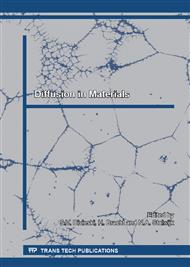p.85
p.91
p.101
p.106
p.112
p.120
p.127
p.130
p.133
General Approach to Diffusion under a Stress in Metals and Interstitial Alloys
Abstract:
One of the main aims of our work is to obtain general equations for the diffusion fluxes under strain that give the possibility for using these equations at low temperatures, as in this case the strain influence on the diffusion fluxes is manifested in maximal degree. Our approach takes into consideration that the strains can alter the surrounding atom configuration near the jumping atom and consequently the local magnitude of the activation barrier and a rate of atom jumps. The approach is derived under assumptions that the total energy depends on the pair distances only and the attempt frequencies are the same for all jumps. The rates of atom jumps in different directions define the flux density of the defects. Now we take into account that the strain tensor is different at the saddle point and at the rest atom position, that differentiates our approach from previous ones. As a result, general equations for the vacancy fluxes and impurity fluxes are obtained for fcc and bcc metals. These equations differ significantly from those obtained earlier.
Info:
Periodical:
Pages:
112-119
Citation:
Online since:
May 2015
Authors:
Keywords:
Price:
Сopyright:
© 2015 Trans Tech Publications Ltd. All Rights Reserved
Share:
Citation:


